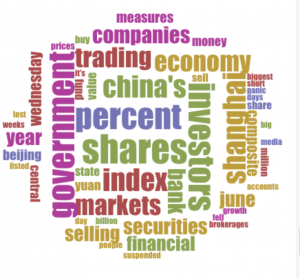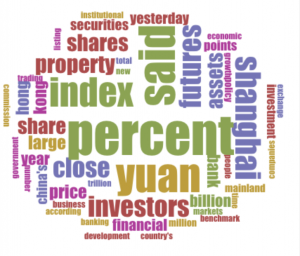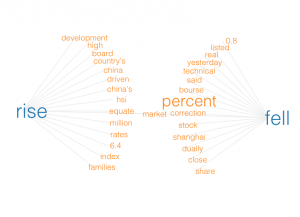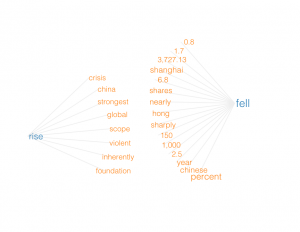A Analysis of News and Chinese Stock Market
- Construction of corpus
The topic that I was focusing on is the Chinese stock market. I would like to see if there is any possible and clear connection with the news report on Chinese stock market and its turbulence (bull(good and rising) market and bear(bad and falling) market). I chose two critical time period in Chinese stock market: the biggest bull market in 2007, and the recent bear market in 2015. Around 30 news were fetched manually for each of the time period from 5 major english news portals: BBC, USNEWS, Chinadaily, Reuters and NY times. These news are very relative to the topic because I chose them subjectively and I picked a little earlier in the timeline as I was wondering if the news report foresee the upcoming rise or fall in the stock market.
- In Voyant
These two are the word frequency picture of the bull(top) and bear(bottom) market. After I clear some of the misleading words like “china” and “stock”, these two pics look reasonable enough. People need to dig into a very subtle level, ignoring all the stock terms like “percent” and “index”. According to the left picture, we could see there are “selling” “fell” “brokerages” and “lost” shown up quite a few times. But on the right one one of these appears. Instead, “large”,”development” and “growth” seems to be appearing in many news report.
Again, we could see the words connection in Voyant. In the top left one (bull market), rise has 17 connections while fell has 16. While in the right one rise has only 3 connection but fell has 21. And in the bear market one the word “rise” sometimes are related to “crisis”.
- In Jigsaw
It is almost the same scene in Jigsaw but Jigsaw focus more on the entities rather than certain word. So in my research of the connection between news and stock market, Jigsaw is somehow less useful than Voyant. But one thing I found very interesting is the sentimental analysis.
These two bars represent the sentimental value of each text. The more blue or right, the more sadness or bad words in the text. The more red or to the left, the more happy words in the text. Without even a guess, people could clearly see that the top one refers to the bull market while the bottom one referring to the bear market.
This sentimental analysis is crucial because when people want to know how the stock market acts, the most convenient resource for them is news report. And according to the sentimental analysis, they could foresee the upcoming turbulence of jump in the market, hopefully.
- Comparison
I would say the these two platforms are all very useful but the work in different ways. Voyant seems to be more compatible with every kinds of text, no mater long or short because Voyand is taking every text together to analysis (comparing to Jigsaw). But Jigsaw is more picky in texts. You have to give Jigsaw a lot different text so that it could do the entity identifying. I’d say that for some certain area of research, Jigsaw would be more appropriate. I use Voyant more in my whole research.
- Conclusion
As for Tenya’s argument, I don’t know if there is a right answer but I do think that by doing text analysis people would see a lot of things and connections that they would not know if they just see the text in total. “these cameras and the resulting images” did provide me with very multidimensional and interesting aspects of the resources. I would like to work on it more with my major topic if I have chance in the future. I believe it would be very though provoking to link math with statistical texts.




Leave a Reply